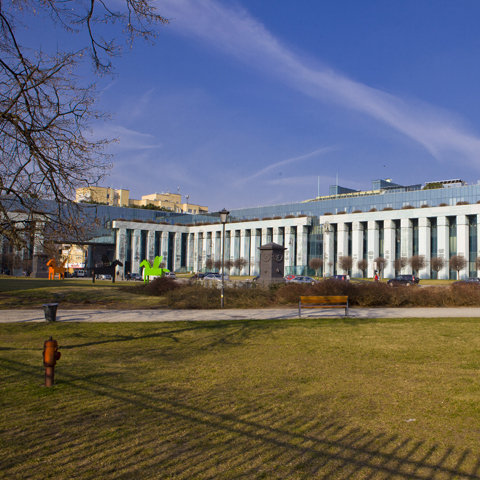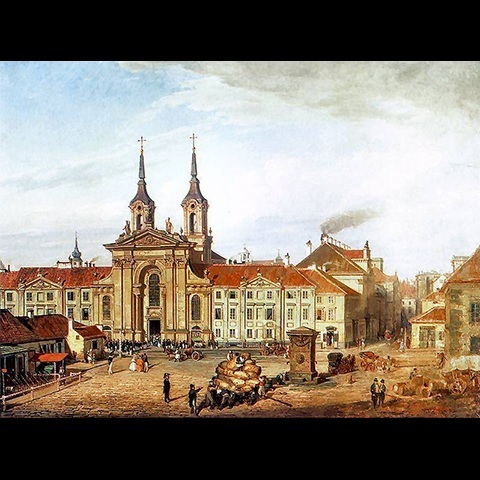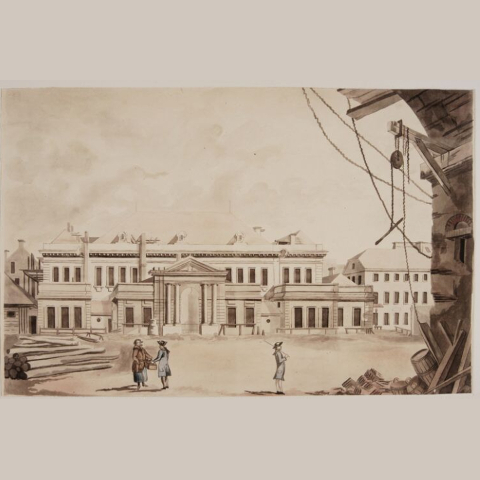Composers / Fryderyk Chopin / Places catalog
National Theatre
‘Bogusławski arrived from Lwów [now Lviv, Ukraine] a few years after the Warsaw Theatre had closed. He managed to gather up the actors left over from the time of King Stanislaus Augustus and complement his “troupe” (to use the word in vogue then) of Polish actors with new artists. The Polish stage was enthusiastically welcomed by the Warsaw public when it was first opened, and the performances that have been put on since have been extremely well attended. This degree of popularity could be attributed neither to a love of the thespian art, such as existed in France, nor to any special favour granted to artists or any desire to spur them on to artistic excellence. It mainly had to do with the fact that the theatre was the only place where the Polish language was spoken to an assembly of people for whom listening to this speech, which differed from that used in their colloquial conversations, was to some extent necessary. The director tapped into this popularity by staging performances that either evoked pleasant memories of the past or aroused feelings of wistfulness […] But I have to add that apart from these emotional and artistic enticements beckoning the public to the Warsaw Theatre, there was another, entirely material, reason that brought people here in droves, and that was that the theatre was considered a general meeting place where friends could see each other. Many people who really wanted to meet up came here precisely for that reason. It should be pointed out that the Warsaw Theatre had neither chairs not benches and that the stalls were like a great big hall around which the audience constantly walked en masse, except when congestion prevented them from doing so or when something of momentary interest or an artist’s playing caused an involuntary pause. This, however, hardly ever happened and should be considered the exception. The rule was that the people in the stalls constantly greeted each other and conversed (sometimes preventing the actors from being heard), communicated with people in the boxes by glancing, bowing or winking, paid visits to the ladies in the boxes with no concern as to whether opening and shutting doors disturbed the performance, offered them cold borsch and sweets, and hatched real plots – sometimes more intricate than those unfolding on the stage’.
That is how Fryderyk Skarbek described the Warsaw Theatre on Plac Krasińskich (where the Supreme Court stands today). Skarbek was not only a statesman, but also a talented writer. His novel Pamiętniki Seglasa [Seglas’s memoirs] was actually a fictionalised description of Warsaw during the first decades of the nineteenth century, as seen through the eyes of a tutor from France (the prototype of whom was none other than Mikołaj Chopin).
The Theatre fulfilled many and varied functions at the time (largely sociable, if Skarbek’s reproof is anything to go by). Serious theatrical works were staged there, along with lighter fare, and operas and operettas. Concerts were held there as well, although the programmes differed significantly from those of today. ‘It should be mentioned […] that the Theatre played a leading role in the life of Warsaw in those days (as it does today)’, writes Ferdynand Hoesick solemnly. ‘The whole of Warsaw, people of every class, went to the theatre, which was then on Plac Krasińskich (today’s Grand Theatre was built in “Marywil”).’
It can be assumed, therefore, that a concert in such a popular, well frequented place would have been a sociable event, as well as an experience and a challenge for a young artist like the twelve-year-old Fryderyk Chopin.
Already familiar to the Warsaw public from playing in salons, at benefit concerts and before smaller gatherings, Chopin made his debut at the National Theatre with two concerts on 17 and 22 March 1830. He played his Piano Concerto in F minor, Op. 21 on both occasions. On the first night, this was followed by a performance of the Divertimento for horn by Goerner, before Chopin played his Fantasy on Polish Airs in A major, Op. 13. On the second night, the concerto was followed by Variations by Bériot, and then Chopin played his Rondo à la krakowiak, Op. 14. The concert on 22 March finished with Chopin improvising on themes from Jan Stefani’s Krakowiacy i górale [Cracovians and highlanders] and Karol Kurpiński’s Nowe Krakowiaki [New Cracovians] (‘To tell you the truth’, Chopin later confessed in a letter to Tytus Woyciechowski, ‘I improvised not as I had wished, because it was not for that world).
From the account that Chopin wrote for his friend a couple of days later, it is clear that his first public appearance did not enjoy quite the success of his second, possibly on account of the inappropriate choice of instrument. ‘Elsner complained that my pantaleon [piano] was dull, and that you couldn’t hear the bass passages’, he explained, ‘[…] and in the second concert I played not on my own, but on a Viennese instrument’. Although familiar with the ways of Warsaw audiences, as described by Skarbek, it is no wonder that ‘those in the stalls complained that I played too quietly”.
Chopin appeared at the National Theatre again on 11 October to give a farewell concert, shortly prior to leaving Warsaw forever. The mood in the capital was restless, which is probably why the concert did not get a lot of coverage in the press. Such reviews as there were, however, were laudatory: ‘Last evening was an extremely pleasant one for music lovers’, read the one in the Kurier Warszawski [Warsaw courier] of 12 October, ‘the audience numbered around 700. The new concerto, in E minor, composed and performed in public for the first time by Mr Szopen [Chopin], was deemed one of the all-time great musical compositions. The Adagio and Rondo went down especially well. The composer-cum-virtuoso was greeted with thunderous applause, showered with more of the same after every solo, and called back when he had finished’.
-

Krasiński Square. Place where was situated National Theatre. Phot. Waldemar Kielichowski.
-

Krasiński Square. Place where was situated National Theatre. Phot. Waldemar Kielichowski.
-

Marcin Zaleski, Krasiński Square with the Church of the Piarist, oil painting, 1830, collections of the National Museum in Warsaw.
-

National Theatre in the Krasiński Square, Zygmunt Vogel. POLONA